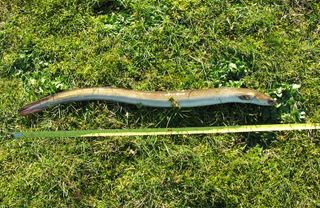Something's Fishy: Did 'Oldest Eel' Really Live 155 Years?

Last week, a man in Sweden claimed that his pet, a freshwater male eel named Åle, died after having lived for 155 years in a backyard well. But was Åle really the oldest eel to have ever lived or the star of a fish tale?
Eel experts aren't sure. In the wild, eels die after spawning, or reproducing, said William O'Connor, a biologist and eel expert with Ecofact Environmental Consultants Ltd. in Ireland.
"Typically, males would be expected to live up to 15 years, and females up to 20 years, but it is known that they can live longer than this, and there is much variation," O'Connor told Live Science in an email. [See Photos of the World's Freakiest-Looking Fish]
Because Åle the eel never left his home to reproduce, it's likely that he would have lived longer than the standard 15 years, O'Connor said. Another eel, named Pute, lived for 85 years in a Swedish aquarium, according to O'Connor. There is also record of an eel held in a well in Denmark for 55 years, he said.
Why would an eel hide out in a well for so long? Apparently, before homeowners had water filtration systems, they would place hungry eels into their wells to clean the water of its insects, O'Connor noted. "However, I don't know how widespread this was," he said.
Even for an eel sealed off in a well, living for 155 years is something that O'Connor called "quite a stretch."
"It is an interesting story, and I am always delighted when eels are in the news, even though I am a little bit skeptical that this eel was really this old," he said.
Sign up for the Live Science daily newsletter now
Get the world’s most fascinating discoveries delivered straight to your inbox.
But the world will know soon enough whether Åle the eel really lived for more than a century and a half. Tomas Kjellman, whose family has owned the well where Åle resided since 1962, told Swedish news website The Local that Åle's remains have been frozen and will soon be transported to the Swedish University of Agricultural Science's Institute of Freshwater Research. Experts there should be able to determine the eel's true age.
By examining the eel's ear stones — hard, bonelike structures within the ear canal — scientists should be able to determine Åle's age, according to Håkan Wickström, a scientist with the Institute of Freshwater Research in Stockholm. Much like determining the age of a tree, scientists can count the "rings" of the ear stones to determine the age of the fish, Wickström told Live Science in an email.
Wickström concedes that examining these tiny fish parts is the only way to know for certain how old Åle truly was when he died. However, he also said that he doesn't think it's impossible for a European eel to live to be 155.
"In another eel species, the large long-fin eel in New Zealand, there are individuals more than 100 years in age in natural waters," Wickström said. "So, 155 years is at least theoretically possible in a well with no predators, cool temperatures and sufficient food."
Recently listed as critically endangered, European eels (Anguilla anguilla) have slowly disappeared from Europe's waterways over the past 30 years, according to O'Connor. However, these creatures have made a comeback recently, with more baby eels turning up in European rivers, but scientists aren't exactly sure why that is, O'Connor said.
In fact, much of an eel's life cycle is shrouded in mystery, O'Connor said. If Åle's tale turns out to be true, the wizened old eel could help biologists gain a better understanding of what he called "fascinating and vulnerable creatures."
Follow Elizabeth Palermo @techEpalermo. Follow Live Science @livescience, Facebook & Google+. Original article on Live Science.

Elizabeth is a former Live Science associate editor and current director of audience development at the Chamber of Commerce. She graduated with a bachelor of arts degree from George Washington University. Elizabeth has traveled throughout the Americas, studying political systems and indigenous cultures and teaching English to students of all ages.
Most Popular

